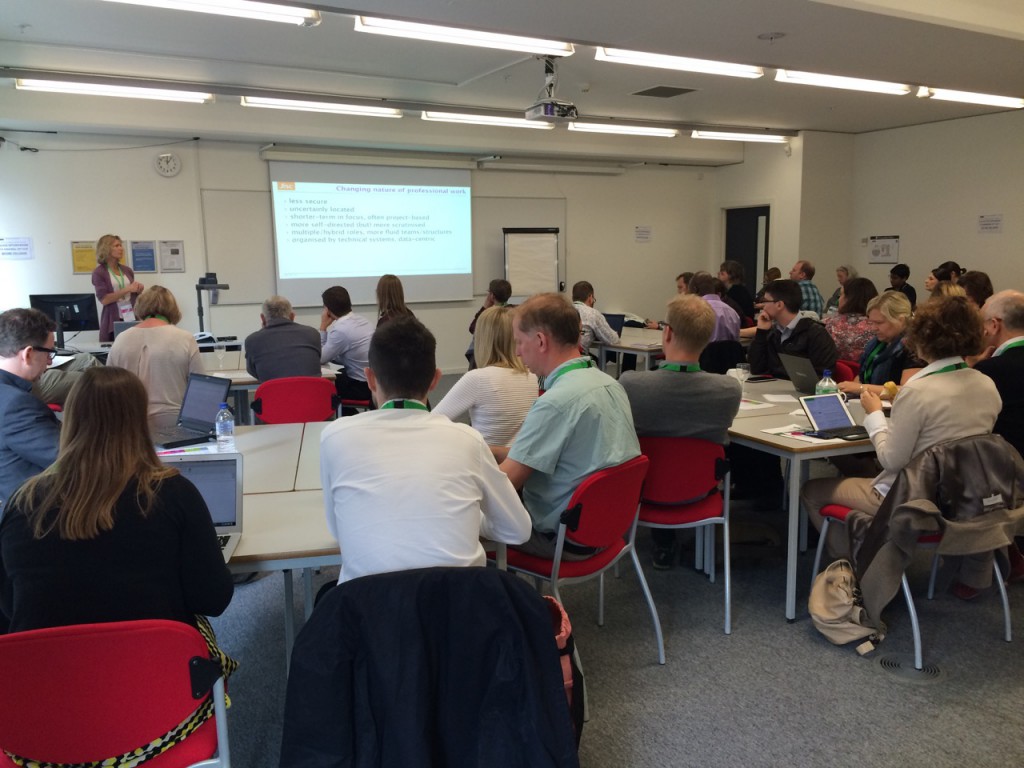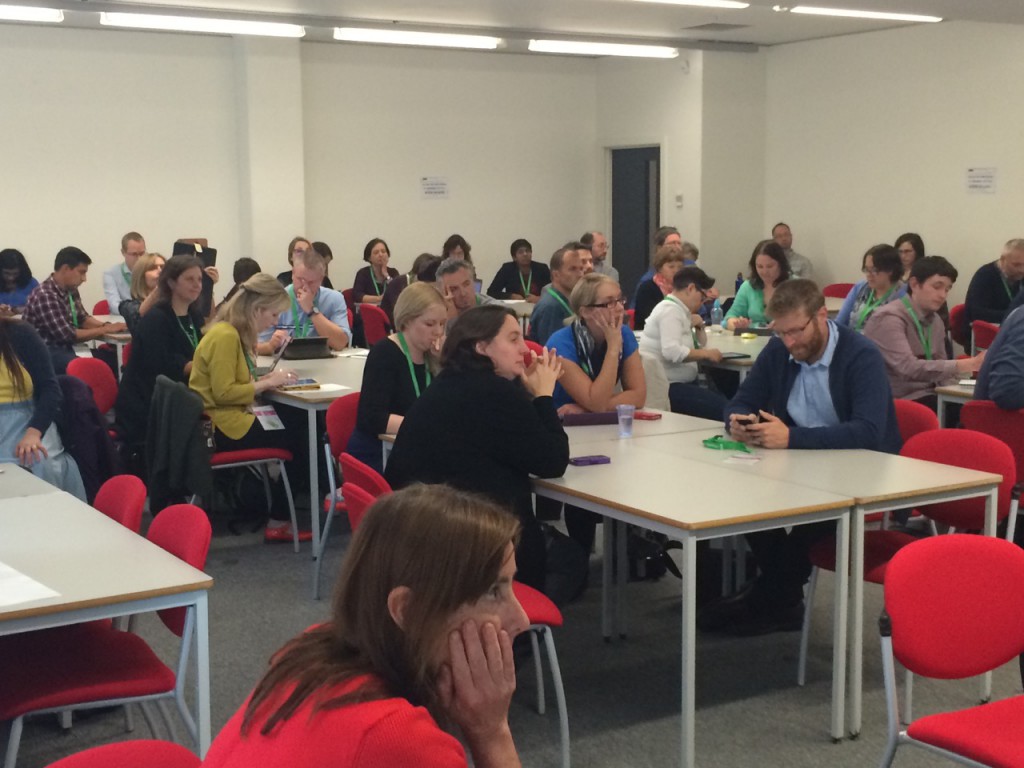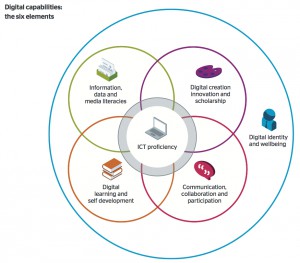Last week I was in Manchester for ALT-C 2015, the biggest learning technology conference in the UK with over 500 delegates. This is the event where learning technologists, heads of elearning and TEL descend to find out and share what’s new.
There was lots of discussion and chatter about digital capabilities and the digital capability framework. On Wednesday as part of the programme, Helen Beetham delivered a session on the framework to a packed room.

The session entitled, Here Comes Everybody: digital capabilities across roles and boundaries [908], the abstract says:
Education professionals are developing new skills and practices to meet the new demands: supporting digitally-enabled students; teaching new digital subjects; researching new questions with innovative methods; publishing in open journals; working in transformed spaces and organisational structures. Being digitally ‘able’ has different connotations in different subject areas and professional roles. But whatever new specialisms are required, the extent of change in working practice means that digital capability is no longer about adding on skills: it is about profound changes to professional and academic identities and to how academic work is valued.
Jisc has recently commissioned work on how the new digital professionalism in education is being framed. This has involved research into literature and practice, and interviews with over 60 professionals. Importantly, it has involved consulting with the professional and representative bodies whose members are dealing with these issues in their daily lives. Just as digital capability can no longer be owned in one part of the institution or by one group of professional staff, so there can be no overarching account that meets everybody’s needs. But there is a need to share our understanding of the direction of travel, and our experiences of meeting new digital challenges with positive modes of professional and organisational development. To support this shared approach we have worked collaboratively to identify how the demands on education professionals are changing and are likely to change over the coming 5 years and beyond. From this foresight we have developed a high level framework that maps six elements of digital capability to different professional roles.
Our research indicates that high level frameworks are useful for cross-boundary conversations and for establishing a shared sense of direction. The overall goals are that:
- institutions understand, plan for, develop and reward the digital capabilities that enable them to thrive;
- professional bodies develop and achieve recognition for the digital capabilities of their members;
- individuals develop and achieve recognition for their digital capabilities in the context of their chosen work.
Good practice exists in all these areas but the processes themselves are not always well connected. It is difficult to get a joined-up view of expertise across an organisation. It can be difficult for individuals to gain recognition across the different roles and spaces in which they have digital know-how. By working with professional bodies and with pilot institutions, we are exploring how the high level framework can be expressed within existing processes such as accreditation and recognition, professional and organisational development, role definition and career management, and how it can be reframed to fit new contexts.
The content of the session resonated with people in the room and during the round table discussions, I heard lots of positive comments and interest in the framework and the project as a whole. It was evident from those conversations that people like the framework and see it as a useful tool to discuss digital skills and capabilities. There is a demand for some kind of diagnostic tool to assess staff skills in digital and support in helping those same staff to improve their skills.
As with many conference sessions, people wanted to continue the discussion after the allocated time, which demonstrated the interest people had in the content of the presentation.
The day before Lawrie Phipps and Donna Lanclos, in their session, asked Are learning technologies fit for purpose [881].
Though not badged as digital capabilities, Lawrie introduced the session with the digital capability framework diagram.
The session which followed the conversation at Jisc’s Digifest 15, and had the following abstract
Early in 2015 the authors participated in a debate about the fitness for purpose of the most common learning technologies currently in use in higher and further education. The debate covered broad issues such as the fitness of education, technological determinism and cyber security. Following the debate the authors continued engaging with a wide range of people in the sector arguing both for and against the use of bespoke learning technologies.
The main arguments proposed for the continued use of learning technologies centred around three underlying assumptions:
- That the key purpose of institutional e-learning technology is to deal with educating at scale;
- That students require ‘safe digital spaces’ in which to engage with their courses;
- And that students benefit from technology that presents the course (and its curricular structure) as the organising principle rather than the common Web based/Social Media focus on the individual.
An alternative viewpoint, rather than countering, was also proposed on three assumptions;
- That the purpose of a university education (of any education) is to prepare students for life after university, not just to get them a job. Therefore the systems with which they interact in the course of their education should not be hermetically sealed from the realities they need to confront on the other side of the degree;
- That these are content-centric systems promote stale content; once the material is deposited there it gets fossilized, reused and unchanging after term after term of teaching the same course;
- And finally that by deploying bespoke institutional systems we are abdicating our responsibility to both staff and students in recommending that these systems are the best fit for their practice, rather than engaging in a critique of what tools are best able to leverage learning.
This presentation and paper will open up the debate, reporting on discussions and engagement after the original debate and eliciting more viewpoints to further the discussion and encourage delegates to think critically about their existing use of technology. It will also propose a continuum of practice with technology, seeking to not identify a right or wrong answer, but instead provide a series of questions, checks and balances that institutions should consider in their deployment of technology.
Finally the session will look beyond the original question, and ask delegates to think critically about their own practice with these technologies. If we have concerns, or consider the use of learning technologies to be worthy of further critical investigation then what does it mean for professional practice, and what sort of checks and balances must we consider putting in place to ensure that we are always acting in the best interests of staff and students.
This was also a packed session, with lots of discussion and debate. With so many people a less formal approach was used by Donna and Lawrie, but this did not detract engagement in the session.
One clear conclusion from the session, was that the technology was less important than the leadership, management and skills of the people involved in the delivery of learning.
 As well as those sessions we also gave people a chance to chat about digital capabilities on the JIsc stand. I spoke to lots of delegates at the stand about the project and what we are planning. Lots of keen interest in the framework, but also the other facets of the building digital capability project.
As well as those sessions we also gave people a chance to chat about digital capabilities on the JIsc stand. I spoke to lots of delegates at the stand about the project and what we are planning. Lots of keen interest in the framework, but also the other facets of the building digital capability project.
Key messages that I took from those conversations and the sessions were:
- People like the framework, the diagram especially resonated with the work they were doing in their institutions.
- People wanted to assess the capabilities of their staff and needed a tool to do this, the diagnostic (or discovery) tool was certainly one aspect of the project that they felt would fufill this need.
- The importance of leadership in building capability and embedding the use of digital technologies, as a result there was interest in the digital leadership programme that is being led by Lawrie Phipps.
- There was also demand for resources to support the development of digital skills of staff, so improving their capability to work within a modern environment that has a range of digital tools and services.
- It was also interesting to hear the demand for tools and resources to support learners’ digital skills and development.
Overall an event like ALT-C was a real opportunity to engage with the community and stakeholders on progress of the project.


